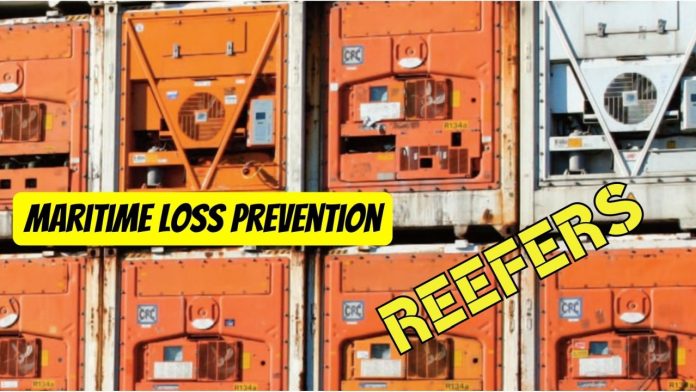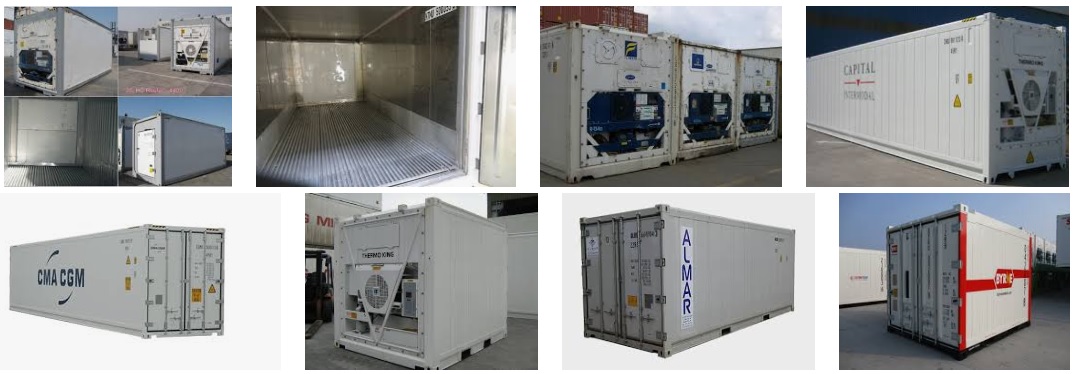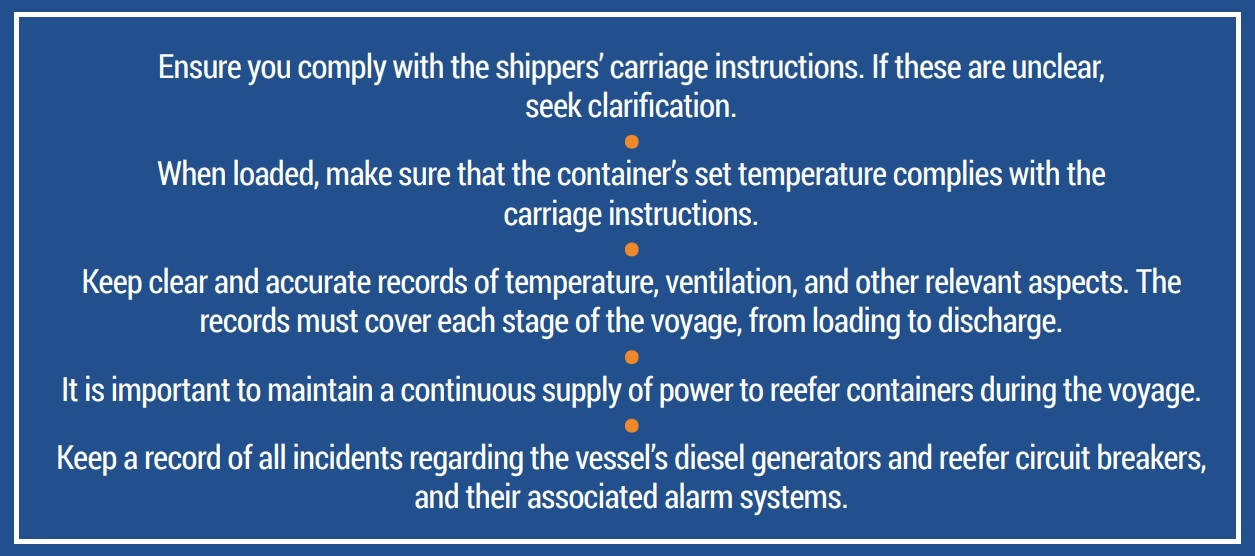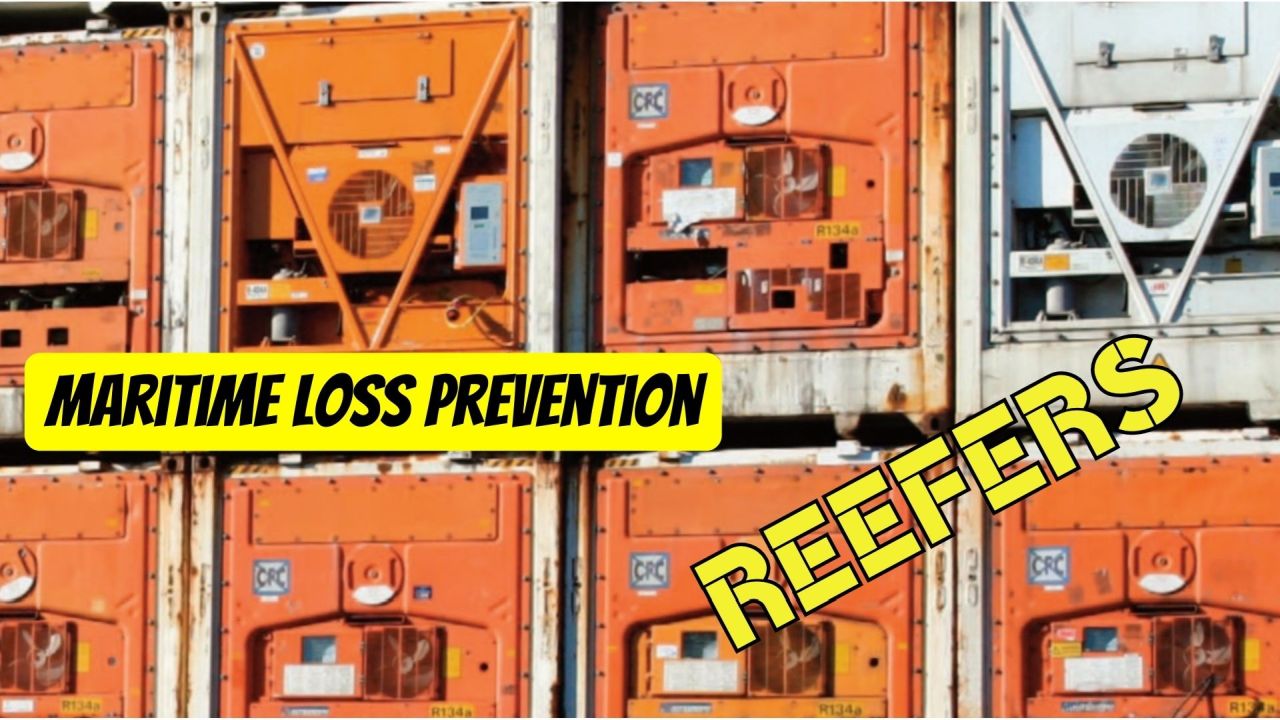
(www.MaritimeCyprus.com) A reefer container is a complex piece of engineering and has, over the years, become more reliable, and can be trusted to transport perishable goods vast distances, with little or no impact on quality.
It is easy to forget therefore, that the vessel crew still has an important part to play in ensuring that these fragile cargoes are delivered safely, and that the actions of those on board can make a significant difference to the claims experienced by an operator.
Reefer containers carry a wide variety of refrigerated goods, of which fresh produce, frozen meat and fish, dairy products and pharmaceuticals are only a few. A single reefer container may carry a cargo value of several hundred thousand US dollars or more.
Each type of cargo varies in its requirements for carriage temperature, humidity, stowage arrangements and ventilation.

Variables to take into consideration:
Temperature
Temperature abuse affects cargoes in different ways depending on the cargo. For fresh or frozen products this might include premature ripening, freezer burn, frosting and textural changes.
To prevent this the crew should check that the container set temperature complies with the shippers’ specified carriage instructions. The external integrity of the reefer container should also be checked for damage with any defects noted and photographed. The shipper should be notified of any physical damage to the container.
Poor airflow/ventilation through the cargo can lead to temperature hotspots developing. This can be due to poor stowage or packaging of cargo preventing airflow through the cargo or over stowage of cargo preventing return air to the refrigeration unit.
Air
When carrying frozen cargo, the fresh air ventilation ducts should always be closed. In contrast, for chilled live cargoes such as fruit and vegetables the products should be stowed to allow air flow to circulate throughout the cargo stow, this will remove product heat, as well as moisture and gases such as carbon dioxide and ethylene.
The exact ventilation requirements will depend on the type of product carried.
Loading
It is important to note that the reefer container is designed to maintain the cargo temperature rather than cool it. Ideally, all cargoes should be loaded at the intended carriage temperature to ensure product quality is maintained.
The most important point for carriers is to ensure that the carriage instructions and set temperature are checked and adhered to at the time the reefer container is loaded.
Monitoring
Continuous supply of power to the reefer containers is also of utmost importance during the voyage. The vessel’s crew should regularly monitor this and ensure that all incidents regarding the vessel’s diesel generators and reefer circuit breakers and their associated alarm systems are meticulously recorded.
Proper container monitoring and prompt action during a voyage will provide helpful information as to whether the carrier should appoint a surveyor to be present for opening of the container at the destination.
Record keeping
In the event of a claim, one of the most effective defences is the maintenance of clear and accurate records and documentation of each stage of the voyage from loading through to discharge.
For reefer containers, the crew can assist by maintaining detailed and accurate monitoring and maintenance logs as well as obtaining date-stamped photographs of incidents that occur during the voyage. However, the container’s datalogger is the most accurate log available.

Actual claims that can happen
Damage to various food products
The container vessel had loaded cargo in a European port, to be discharged in Asia. Several reefer containers with meat, fish and other food had been loaded. The containers had been filled with frozen food at a temperature of -20°C and the container temperature was set to freezing.
During the voyage an AB checked the containers twice a day and logged the temperature at between -19°C and -20°C.
One month later the vessel discharged the containers in Asia. When the cargo receivers inspected the meat, they found it to be thawing. According to the container units’ records, the temperature in the containers had increased over a couple of days after departure from -15°C to +5°C. All the alarms for the containers had been disabled.
The fresh air ventilation to the containers had been open. This allowed a continuous flow of warm air into the containers. Why this had been opened after departure is not known. The cargo was fully rejected and destroyed by the cargo receivers. The crew had not verified the correct temperature of the container but only written down what should have been the correct temperature in the log as the actual container’s digital log showed +5°C and not -20°C as in the vessel’s log.
Meat damaged due to wrong temperature settings
The container vessel had loaded cargo in a South American port, to be discharged in Europe. Several reefer containers with meat were also loaded. The containers had been filled with superior chilled meat at a cargo temperature of around 0°C. The containers were set to chilling mode with a set point temperature of -1.4°C.
For some reason one of the containers was switched to freezing mode with a set point of -18°C and remained at this setting throughout the entire month’s voyage to Europe. On the bill of lading it was stipulated that the container should be kept chilled at a temperature of -1.4°C. However, during the loading operation the agent supplied an initial reefer list which had two separate entries for this container - one stated that the container should be chilled and another stated that it should be frozen.
This mistake was discovered by the crew, and the agent then updated the reefer list confirming the set point temperature as -1.4°C for the container. One month later the vessel discharged the containers in Europe. When the cargo receiver inspected the meat,
it found it to be frozen. The meat should have been chilled as it becomes damaged when it is frozen.
According to the container unit’s records the temperature in the container fell a couple of days after departure. This caused the meat to freeze. Over a sufficiently long time, even a reefer container will achieve solid freezing of the entire cargo. In this case, there was clearly sufficient time.
Each piece of meat was packed in a heat-sealed vacuum plastic liner bag. When the cargo receiver inspected the meat it had turned dark red and slightly brownish and the vacuum bags contained a considerable quantity of blood. The meat which was initially of superior quality could now only be used for lower-end products and had to be sold for a loss.
Damage to seafood
A shipment of containerised boxed shrimps shipped from Argentina to China was found to be badly frosted. The shrimps inside the boxes were also beginning to blacken due to melanosis. Shrimps and crustacea undergo melanosis (an enzyme catalysed oxidation) when they are kept at incorrect temperatures and/or past their shelf life. Melanosis is also related to the freshness of the product at the time of freezing and whether it has been treated with any preservatives. While melanosis is not dangerous for consumption, it is
a quality control indicator, and renders the shrimps unsightly and unsaleable.
The frosting is a second indicator that the product had suffered temperature abuse. Frosting appears when a product is thawed and then partially refrozen. Usually, the boxes are tightly packed into the containers, restricting airflow through the cargo and effectively
insulating the cartons inside the stow compared to the ones in the outside. The product on the inside of the stow would be insulated against the worst damage by the cargo around it. It is then expected to observe a gradient of damage as the condition of the cartons is poorest nearest the door and the external edges of the stow, with the damage lessening towards the rear of the container.
The cargo should always be kept below the load line of the container, away from the container walls and not beyond the ‘T’ bars to allow the refrigerated air to flow freely around the whole of the stow. The container logs showed erratic temperature changes. Seven days after the start of the voyage, the temperature started to rise slowly but steadily from -25 °C to a range between -10 °C to -2 °C at arrival, which is indicative of a refrigeration system malfunction. These temperatures are sufficient for melanosis and
frosting to occur.
The Master and the crew should have been warned of the malfunction and should have made an attempt to repair the container. However, the corresponding alarms were not relayed to the vessel, suggesting a secondary malfunction in the system.
Damage to fresh produce
A cargo of bagged white garlic was shipped from China to Central America. On arrival, it was noted that significant portions of the consignment showed signs of germination. After curing (a process of drying after harvest), garlic can be stored at high temperatures (+25 °C) or low temperatures (-3 to 0 °C) to prevent germination of the bulbs and maintain the storage life of the product.
Temperatures above 5 °C and below 20 °C are not appropriate for garlic storage and can cause dormancy break, advanced germination, and fungal/bacterial issues. It is common to see garlic transported in containers at low temperature (i.e., -3 °C to 0 °C). At these lower temperatures, the heat generated by respiration of the garlic bulbs is removed, helping to maintain a period of dormancy.
The temperature records indicated that it took several days for the temperature to reach +4 °C. Furthermore, the situation was exacerbated by the cargo being ‘hot-loaded’, meaning that the cargo was not pre-chilled before loading. The effect of these two factors was to prevent the cargo from meeting the required temperature range and thus, led to a significant portion of the cargo arriving with unacceptable levels of germination.
The crew should take care when checking, that set point temperatures, as outlined in the carriage instructions, are properly applied to the containers. A failure to do so can lead to the onset of germination and/or spoilage of cargo through bacterial or fungal infections.
Key learnings from case studies
- It goes without saying that a continuous supply of power to reefer containers is of the utmost importance during the voyage. The vessel’s crew should regularly monitor this and ensure that all incidents regarding the vessel’s diesel generators and reefer circuit breakers, and their associated alarm systems, are meticulously recorded.
- The crew should check that the container set temperature complies with the shipper’s specified carriage instructions.
- The external integrity of the reefer container should also be checked for damage with any defects noted and photographed.
- It is important to note that the reefer container is designed to maintain the cargo’s temperature rather than cool it. Ideally, all cargoes should be loaded at the intended carriage temperature to ensure product quality is maintained.
- The crew should keep clear and accurate records. Document each stage of the voyage from loading through to discharge as well as obtaining date-stamped photographs of incidents that occur during the voyage.
- The owner should be aware that charterparties are often based on BOXTIME and, if not amended, any temperature damage to the cargo in reefer containers which is caused by crew negligence is 100% the responsibility of the owner.
- Ensure you comply with the shippers’ carriage instructions. If these are unclear, seek clarification.
- When carrying frozen cargo, the fresh air ventilation ducts should always be closed.
Source: Swedish Club
See more Maritime Loss Prevention Guides by clicking HERE













